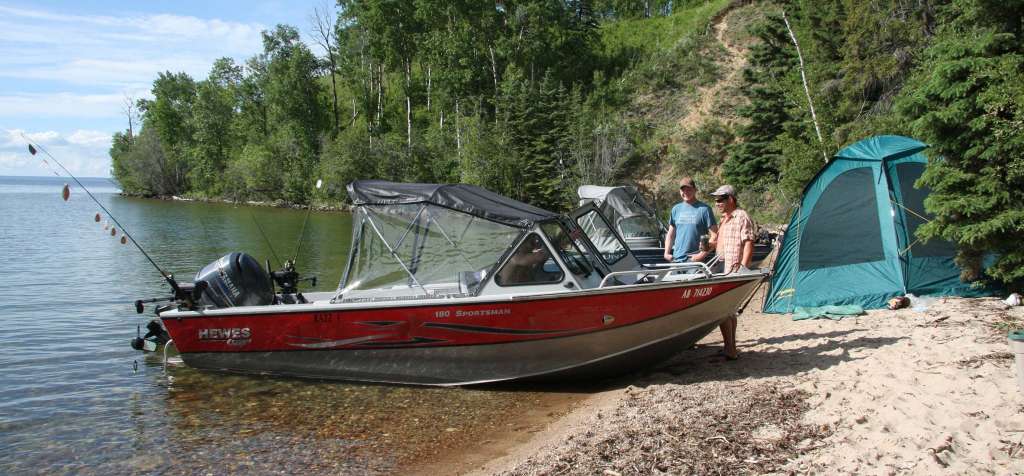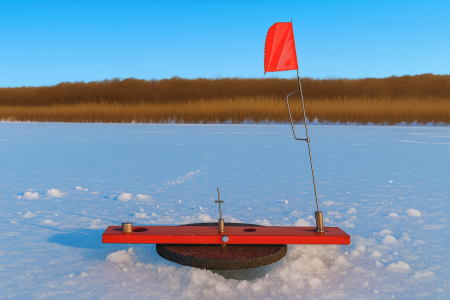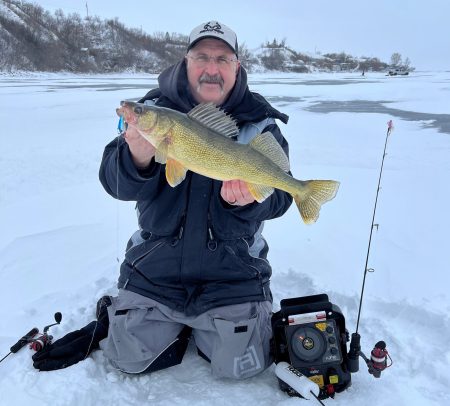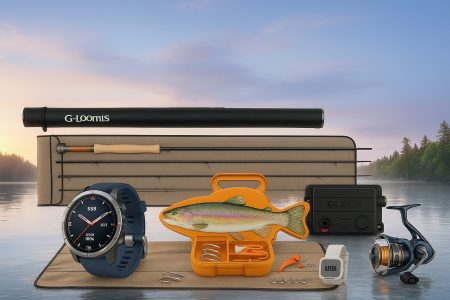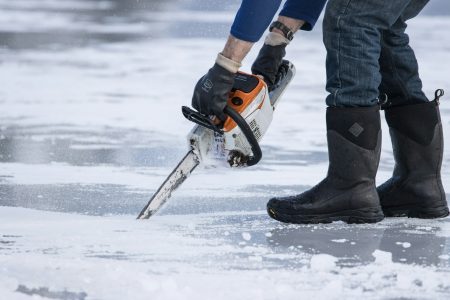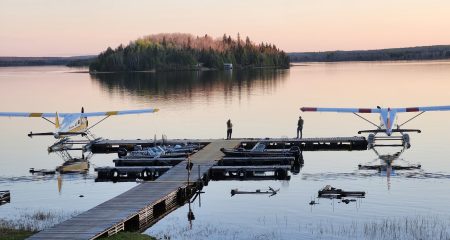We’re dropping our downriggers to 75 and 90 feet. The familiar hum and subtle nod of each rod tip looked perfect. Before long, one dove sharply toward the water and began to bounce.
“Fish on!” chirped my buddy, Steve.
Freeing the handle from its brace, I quickly began to reel while he retrieved the ball and brought in the other line. Sparring with the medium-sized Laker for the next five minutes, it was brought to net and hoisted into the boat. A few photos were captured as we admired the trout’s intricate parr marks and then, as swiftly as possible, we released the handsome fish to be caught another day.
No, we don’t have a true salmon fishery in Alberta, but, in my estimation, we certainly have the next best thing. It’s called Cold Lake, and it is arguably the finest lake trout water in our province.
Located less than a three-hour drive northeast of Edmonton, this gem of a waterbody is as close to an inland ocean as one could hope. This lake measures 144 square miles in size and it straddles the Alberta/Saskatchewan border. It’s also one of the deepest lakes in Alberta, with a maximum depth of 656 feet. Known to hold 24 different fish species, including northern pike, walleye, perch, burbot, and whitefish, Cold Lake is best known for its thriving lake trout population. Plentiful and often big, Cold’s lakers offer the closest thing to salmon fishing that any Midwest prairie angler could ask for. While a variety of angling strategies work, if you follow these proven tactics, you’re sure to hook up in short order.
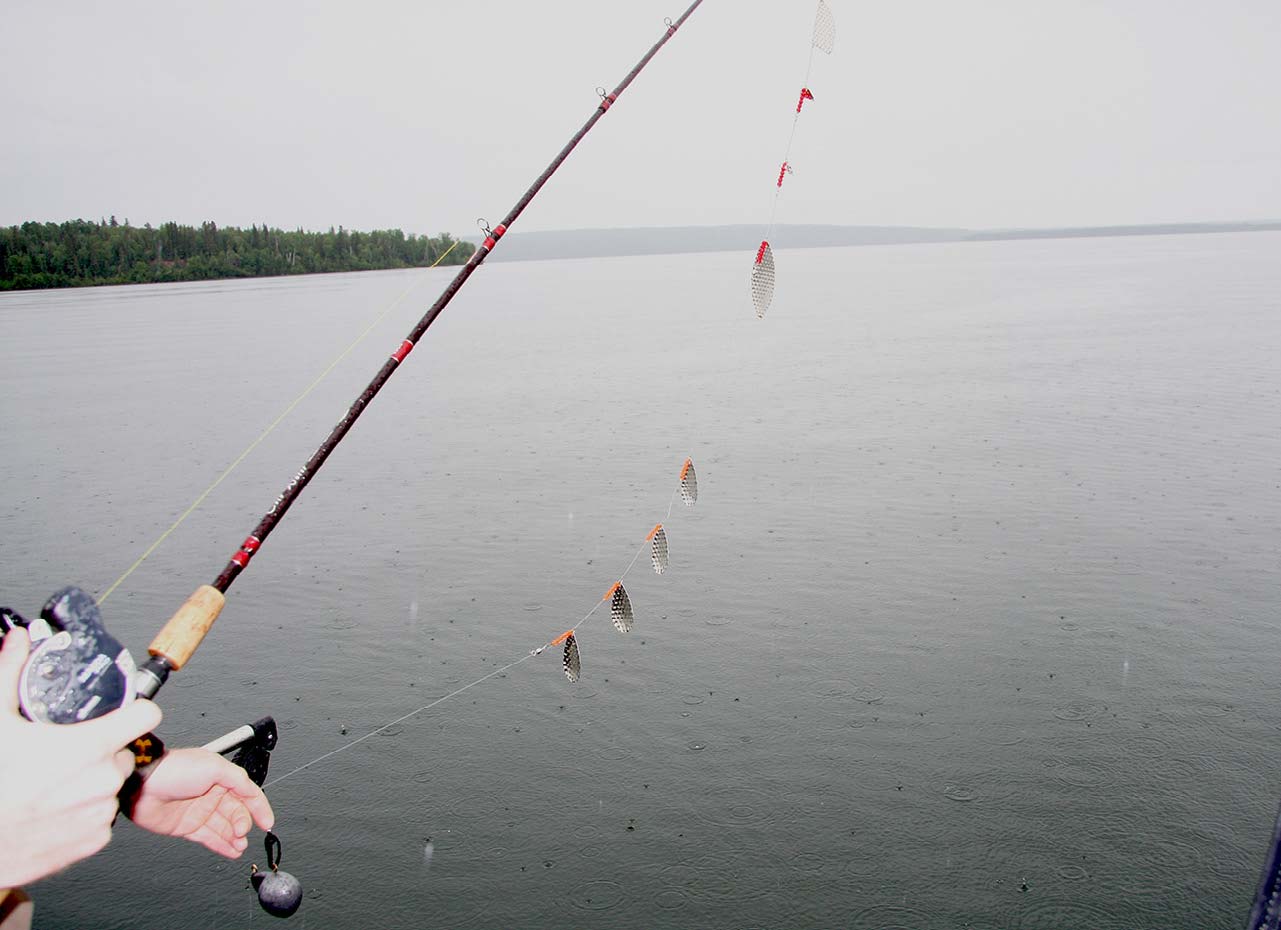
Open Water Strategy
If you’ve fished the Pacific West Coast for Pink, Chinook, or Coho salmon, then you are well on your way to understanding how to fish Cold Lake. On average, you’ll catch lots of shakers in the five-to-eight-pound range, but it is not uncommon to get into trout in the 12-to-25 pound range, either. And, on occasion, tying into 30-pound plus lunkers is not unheard of. Often eager feeders, Cold Lake’s lake trout are abundant. Put a flashy or baited lure in front of them and they are apt to take a swipe at it.
Electronics definitely help a lot. It’s possible to fish without them, but sonars are definitely an asset. Boat control, rods, reels, and terminal tackle are all very similar to what anglers use for salmon on the West Coast. With the size of this lake, it almost has its own micro weather system. Wind can come up quickly on Cold Lake and it can be dangerous. For safety alone, your boat should be capable of handling big water.
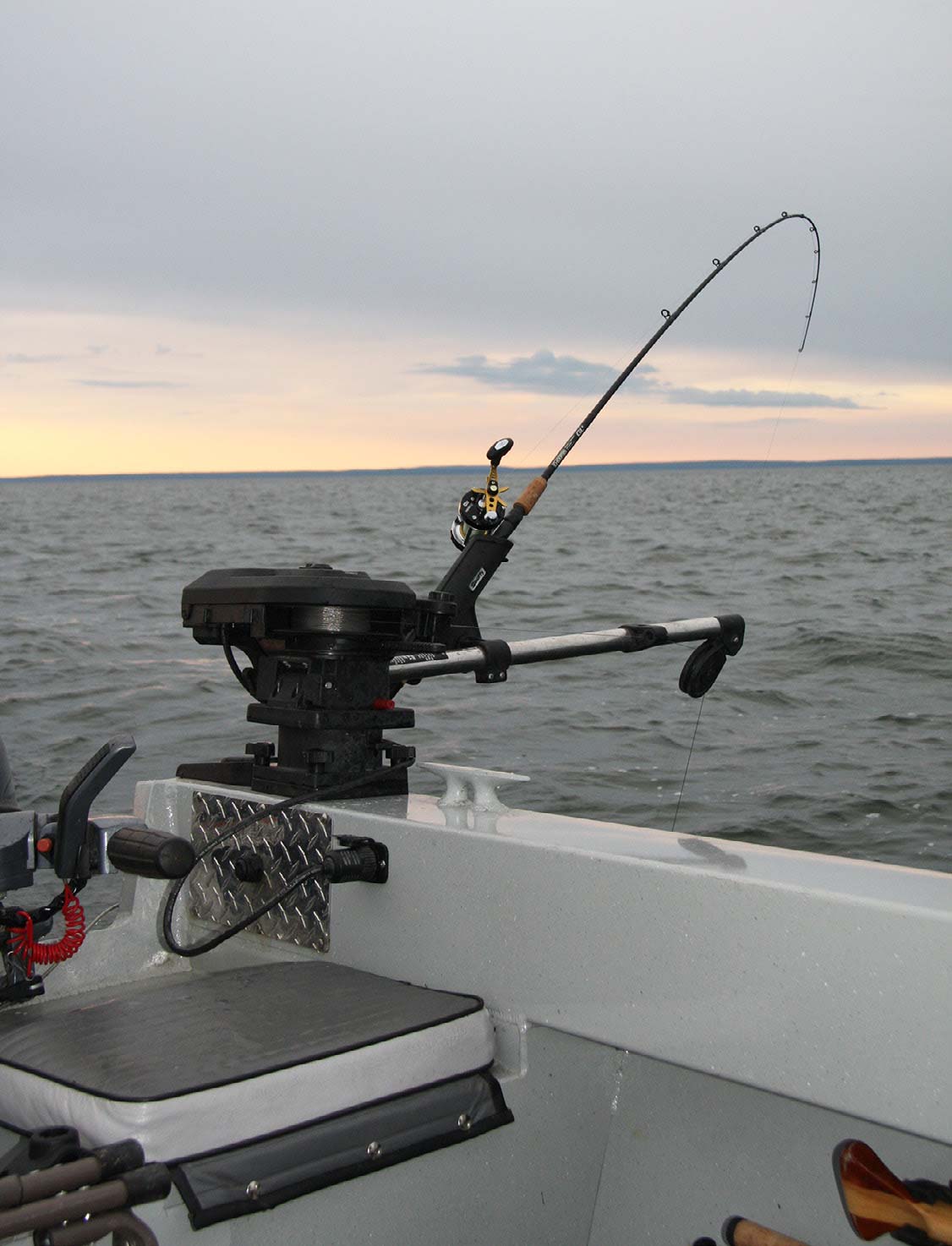
Trolling
Both winter ice-anglers and open-water anglers see success with vertical jigging as well, but during the open water season, trolling with downriggers to control depth and presentation is by far the proven and most effective strategy on Cold.
Fish too deep or too shallow and your odds of catching go way down. Getting your bait and hook down to the thermocline, where the baitfish are hanging out, is the ticket. But equally important is boat control. This means maintaining or varying speed and direction of travel to entice fish to strike. Trout tend to hit a lure or baited hook that resembles their natural forage. If that offering is running too fast, too slow, or with the wrong action, it will look unnatural. Troll at the right speed and you will maximize your chances of enticing a strike. Ideal speed can vary depending on conditions. For example, in rough conditions, increasing speed just a little bit can often be irresistible to lake trout. In my experience, average trolling speeds ranging from 1.9 to 2.2 mph are ideal, with the most consistent action often occurring when we maintain a constant trolling speed of 2.1 mph.
Fish Finder and Asset
To fish Cold Lake effectively, electronics are a huge asset. From the season opener in mid-May throughout the open water season, lake trout fishing can ebb and flow. The best open water action is commonly seen from the opener to the end of July. Employing a good sonar on Cold Lake will help you identify depth, water temperature, structure, assist you in locating the thermocline, find balls of baitfish, and allow you to mark key locations on the electronic map. Locating baitfish should be a priority, as lake trout will be lurking nearby.
From late May on, we typically fish a wide column from 35 to 90 feet of water. In early spring, its fairly straightforward locating the thermocline and you can often catch trout in depths between 45 and 65 feet. In our experience, from mid-June on, we see the best action with suspended fish hovering at depths between 38 and 55 feet.
It’s important to pay attention to water temperature, too. Target areas where the water temperature varies between 50 and 65 degrees Fahrenheit. The thermocline can move up or down, depending on the time of the year. The key is to locate the strata where baitfish are hanging out.

Rods and Reels
Gear options are variable, but a stiff rod blank should be a priority, just in case you tie into one of Cold lake’s giants. While heavier action spinning reels will suffice, seven- to nine-foot medium-heavy action rods armed with level wind reels and 15- to 25-pound test line are best suited for trolling in this fishery.
My favorite lake trout rod is an eight-foot mod-fast G-Loomis Salmon Backbounce (10-20 lb). Marry this, or any comparable rod, with a suitable trolling reel like Abu Garcia’s 6500 LC, with mechanical line counter, spooled with 20-pound mono line, and you’re off to the races. Lake trout ranging from three pounds to well over 20 are common in Cold Lake, but average catches tend to hover somewhere between five and 10 pounds on most days. Work at it, and you will eventually get a trophy over 30.
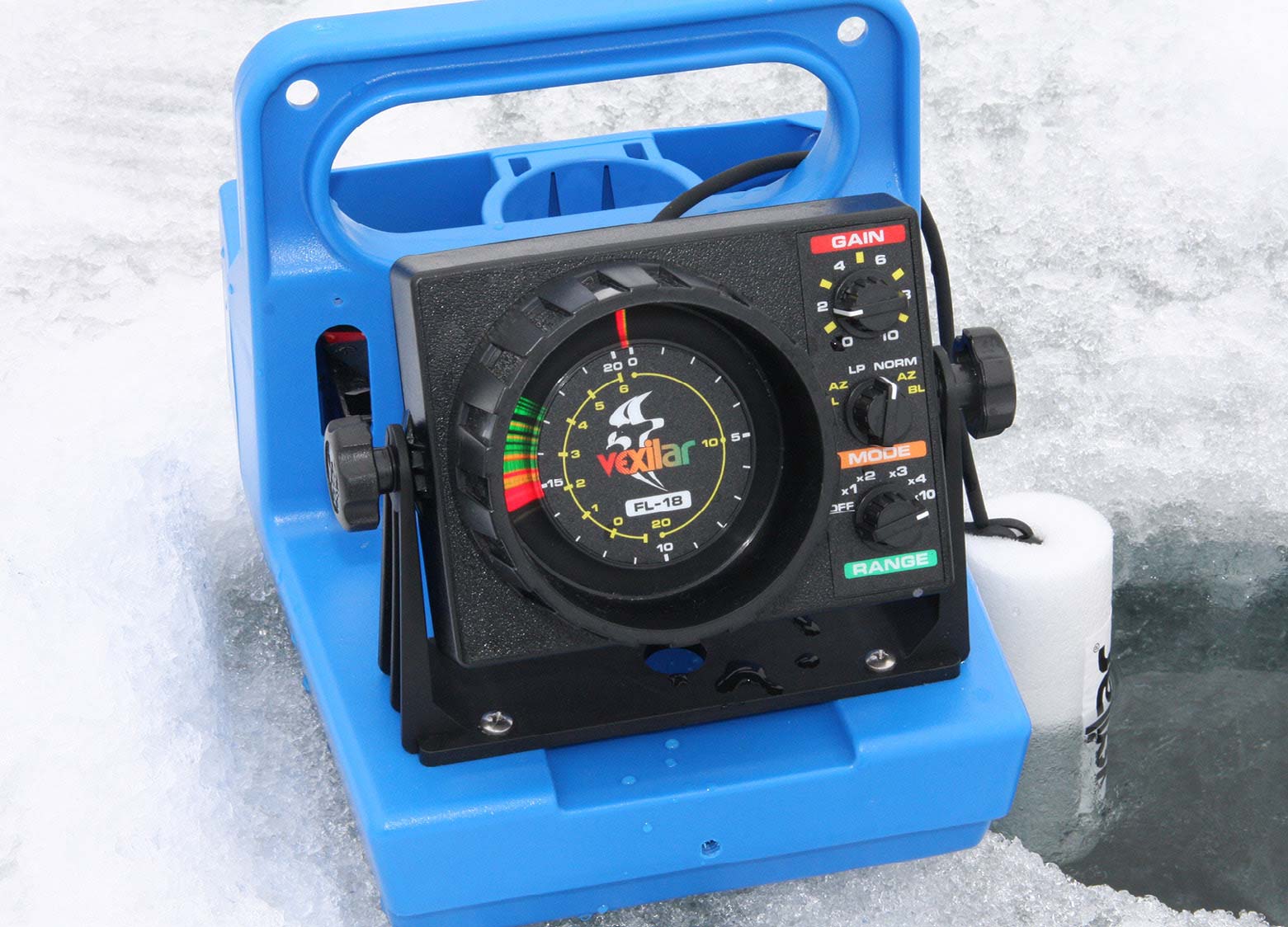
Rigging and Terminal Tackle
If you fish lake trout on other waters, you’re probably familiar with several tried-and-true lures. Things like T-60 Flatfish, Magnum Rapalas, Doctor Spoons, Gibbs Gator, Magnum Jim’s Jigs, and Magnum Len Thompson Five of Diamonds are venerable laker lures.

But, like a lot of fisheries, certain strategies outperform on Cold Lake. Regulations allow the use of bait, so experienced Cold Lake anglers tend to tie on something like a ‘Krippled’ Anchovy Rig (bright for sunny days and darker colors for overcast days), combined with about a four- or five-foot fluorocarbon leader, and something flashy like the Jumbo Willow Leaf Troll. If you run 15 pulls behind the downrigger ball and clip, this rig tends to bring good results.
The ‘Krippled’ Anchovy Rig is a baitfish setup designed in British Columbia for salmon and trout, and it works tremendously well in Cold Lake. Anchovies or Herring can be used, but you may see better success with anchovies. Try inserting the bait head-first into the plastic brace, further securing it with the plastic pin, and attaching the treble hook with a slight curve to the body of the bait. This gives the rig a spiral rolling action that emulates a wounded forage fish trying to escape. The action is often too enticing to ignore, as predatory trout eagerly attack it.
With the ‘Krippled’ Anchovy Rig, proper installation of the baitfish is critical, as is the trolling speed mentioned previously. The action you’re looking for is a moderately slow spiral roll, with one to two revolutions per second. Action is important, so you want to test the rigged bait alongside the boat immediately after clipping it to the downrigger ball. With the desired action, lower the line to the desired depth, and wait for a strike.
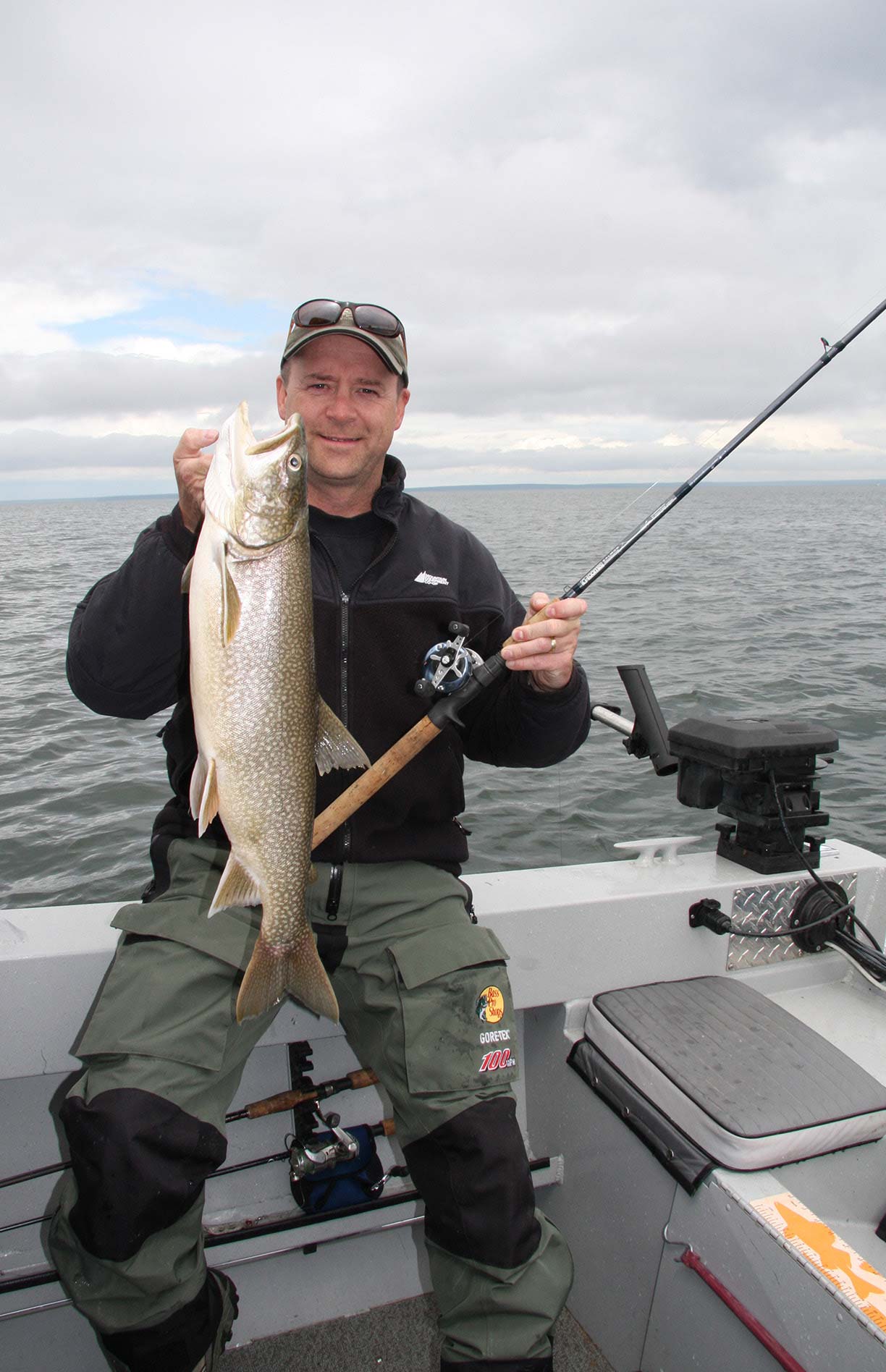
Boats and Cautions
A wide variety of vessels can be seen on Cold Lake, but the most common are larger stable boats with deep bows capable of handling big, turbulent water. One of the more common designs seen on Cold resembles the 18.5-foot Hewescraft. Aside from design, an alternate power source is imperative both for safety and for trolling. Something like a 9.9 hp motor will help a great deal with boat control.
Cold Lake is deep and wide. Those who venture out on this massive lake best be prepared. It is highly susceptible to sudden weather changes. Winds can create dangerous conditions for small vessels. I’ve seen small aluminum boats fishing Cold Lake, but they rarely venture far from shore. Just like on the ocean, most suitable boats are equipped with at least one large and one small motor for backup. A wide hull with a deep bow capable of navigating big waves and traveling at higher speeds is most ideal on Cold Lake.
ICE FISHING COLD LAKE
From December through March, most lake trout are still fairly deep. Look for ledges or sharp contrasts in depth where the bottom transitions quickly from about 60 feet immediately down to 80 or 90 feet. A flasher is almost imperative for ice fishing lake trout. I use a Vexilar FL-8SE. Functional to 120 feet of water with a three-color display, it’s easy to use and helps identify depth and approaching fish.
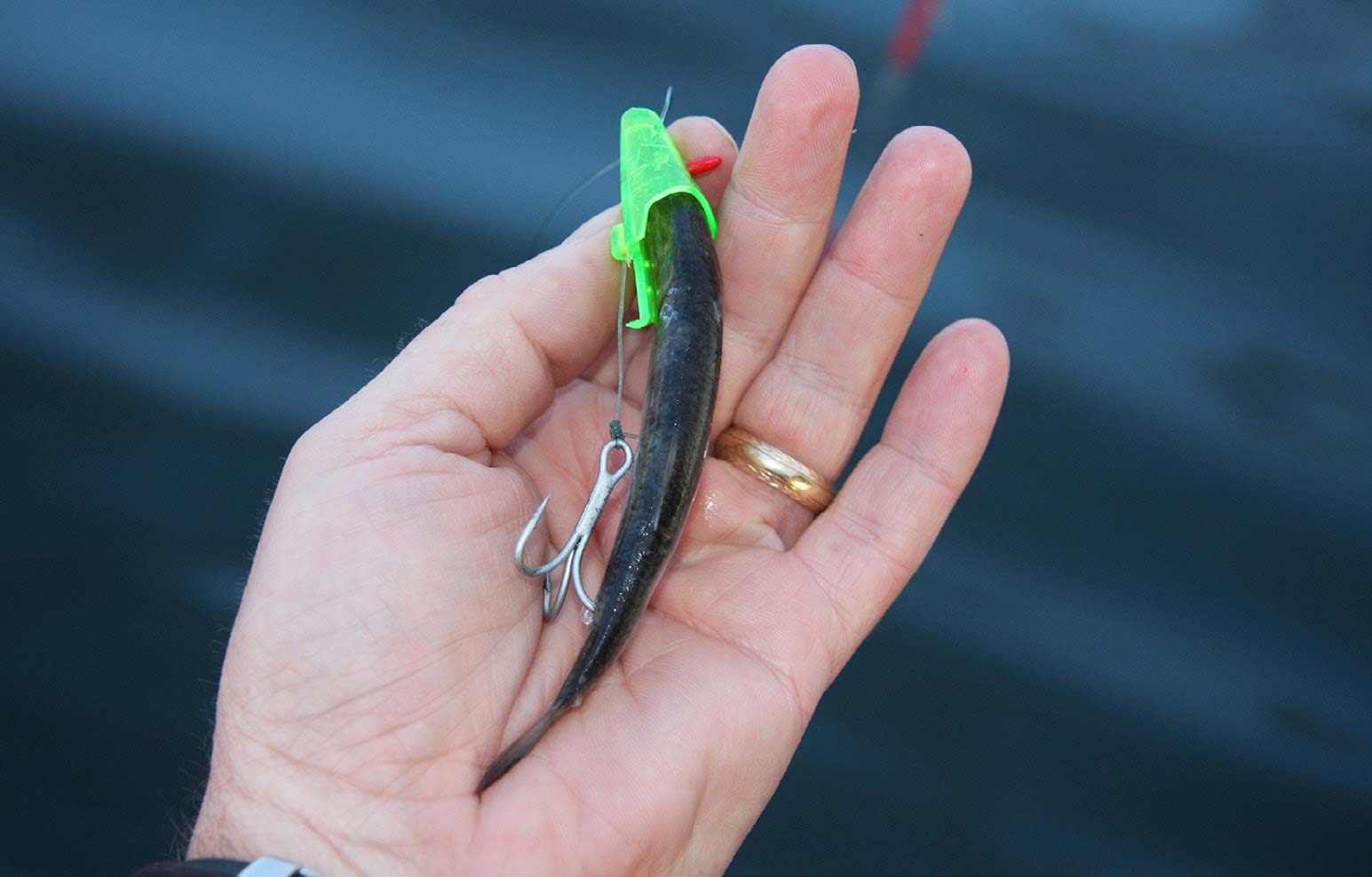
GEARING UP
Comparable full-size equipment works great if you’re outside, but as a rule, if you’re in a tent or other shelter, downsizing to a shorter ice rod is best. I spool reels with at least 10-pound braided line and up to 25-pound test fluorocarbon leaders. My favorite lake trout rig is a one-piece 30-inch medium action Daiwa Triforce 301MFS jigging rod, married with a Shimano Stradic 2500FJ spinning reel.
For lake trout, my go-to lure is either a white, yellow, green, or purple tube jig armed with a smaller minnow. The size of jig head I choose is generally proportionate to the size of tube I’m using, the size of fish I’m targeting, and the depth I’m working. They can range from as small as one-quarter inch all the way up to 1 oz. in size. Berkley Power Tubes and Exude both make exceptional scented soft plastics.
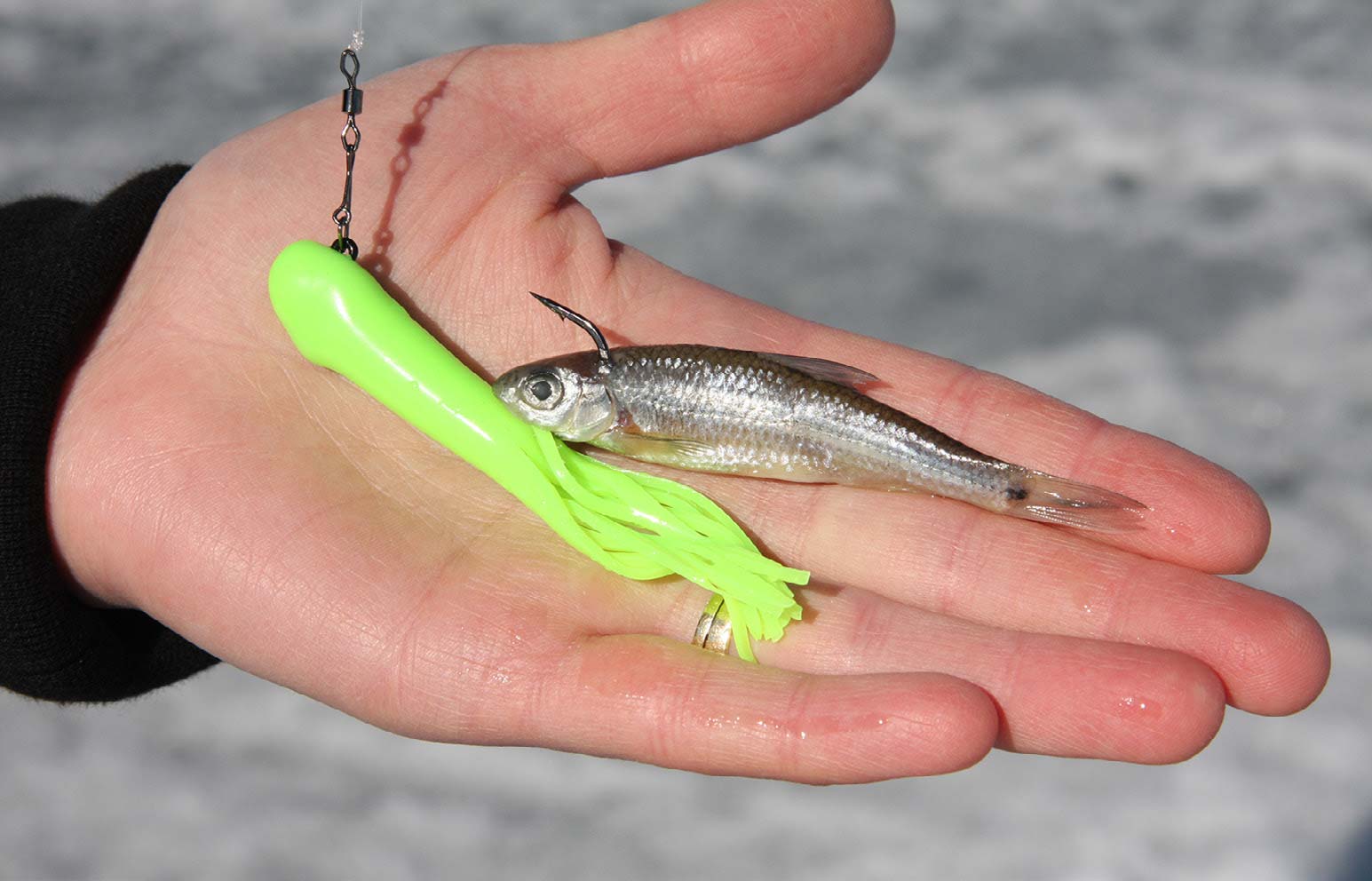
JIGGING STRATEGY
Lake trout can be voracious feeders. When one strikes, it’s likely that a small school is moving through, so be sure to capitalize on the flow of traffic below your hole. With plenty of lure choices available on the market, my favorites include scent-impregnated Gulp tube jigs. However, I’d be remiss if I didn’t mention a few other top lake trout ice fishing lures, including the Williams Whitefish spoons, airplane jigs, white marabou jigs, and Luhr Jensen blade baits. Remember, lake trout are attracted to motion. Any movement that closely resembles a wounded or dying baitfish is ideal. An assortment of jigging Rapalas have been known to work well on Cold Lake also. In my experience, where regulations allow, bait is a must. They are on the prowl, and the scent given off by a shiner, herring, anchovy, or sucker belly is most often too much to ignore. While many anglers believe in using bigger herring or anchovy on their hook in hopes of attracting a larger fish, I’ve learned that bigger spot-tail shiners can be equally effective.
Tube jigs spiral down to their depth and move in a rotational pattern when jigged. At depth I first work my line fairly aggressively every minute or so, and then raise and drop the line, taking care to control the slack, while observing the line for any abnormal behavior indicating a strike.
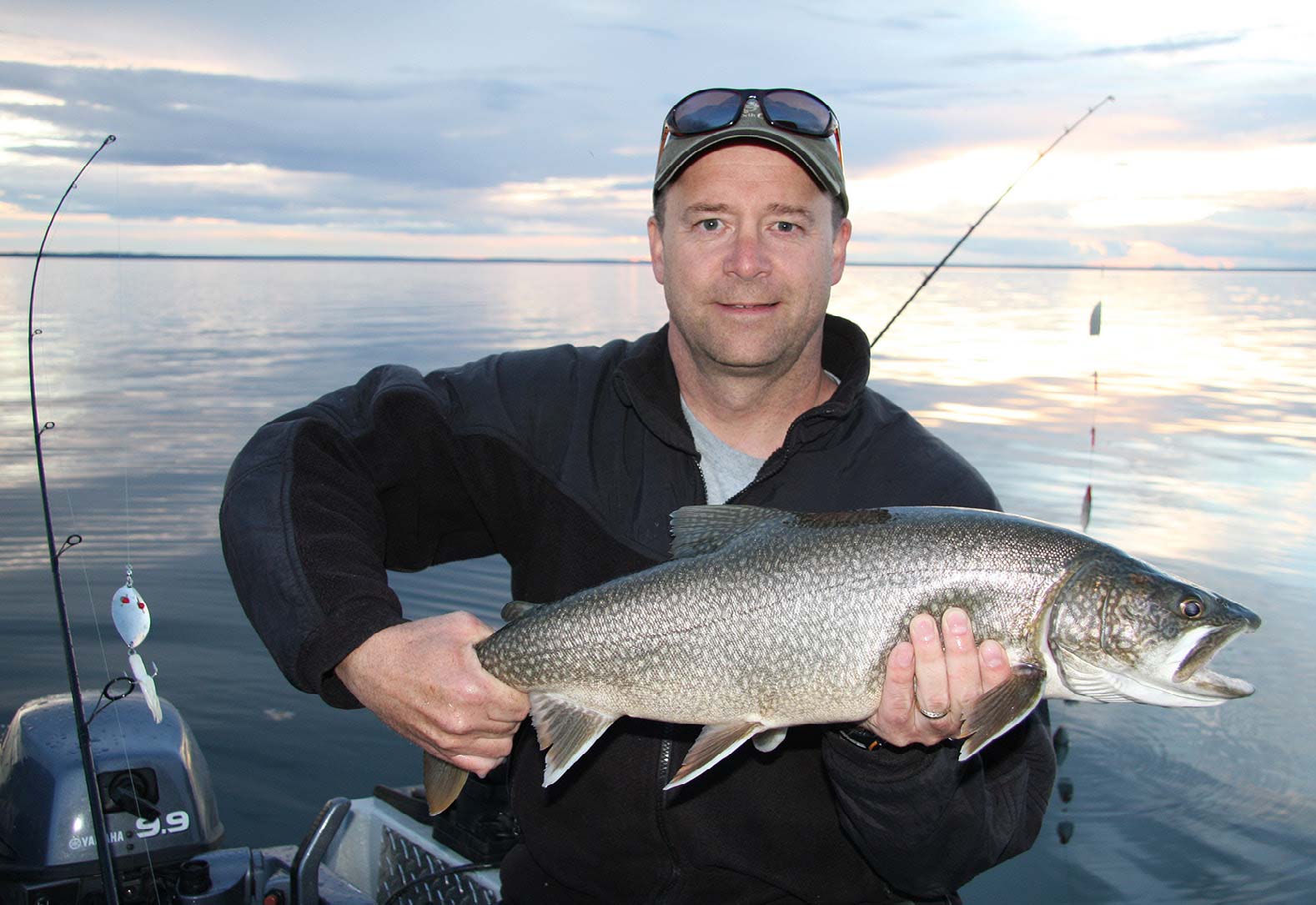
Most takes seem to be on the drop, so it is common to miss a strike. If you see your line tighten, stop, or behave oddly, don’t wait, set the hook and reel immediately. At greater depths, it is easy to miss a strike and lose lake trout when a fraction of a second can mean losing a fish. The key with jigging for trout in deeper water is maintaining consistent movement to attract them. While most anglers drop their presentation and fish the bottom, it can sometimes be better to slowly work your offering up and fish different depths, even midway up the water column. Lake trout are notorious for swimming upward to chase bait. As long as lake trout can see your offering, they will often attack and suck it in just before you raise the rod tip again.
In direct contrast, one of my fishing partners likes to run stationary lines with something comparable to a Carolina rig right near the bottom. He sees success with this relatively motionless presentation baiting his hooks with either a piece of sucker belly or a herring.
By Kevin Wilson
Read More! Check out Mike Hungle’s expert tips on using a Vexilar Flasher Ice Fishing
Per our affiliate disclosure, we may earn revenue from the products available on this page. To learn more about how we test gear, click here.






